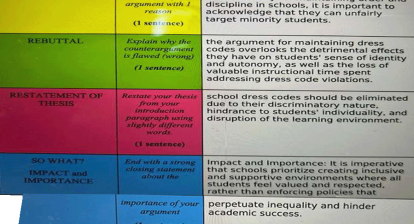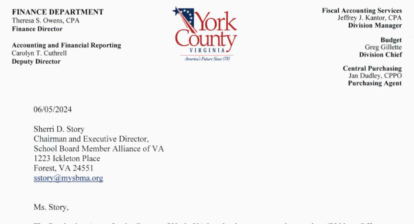In response to “School Safety – A Shared Responsibility Educational Forum,” YCFOIA suggests implementing a K-12 “Red Flag” policy that aligns with Virginia’s current laws for gun owners, which ensure legal protections for due process when someone is reported or flagged. While the idea of a “Red Flag” policy hasn’t been widely talked about, this could be the perfect time to introduce it, especially as it begins to attract more attention.
The following sample policy aims to identify and address early warning signs of potential violence, creating a safer school environment. It should be reviewed and possibly revised by a paid security consultant to enhance its credibility with the School Administration and School Board. While implementing such a policy may involve some costs and additional bureaucracy, it shows a commitment to valuing the safety of students, teachers, and parents.
Sample Policy for Addressing Early Warning Signs of Potential Violence
Objective:
- Create a safer school environment by identifying and addressing early warning signs of potential violence.
- Ensure policy credibility by reviewing and possibly revising it with a paid security consultant.
Key Areas of Focus:
- Prevention:
- Aim to prevent violence by identifying behavioral red flags.
- Ensure compliance with federal laws, including FERPA and Virginia’s Red Flag Law (ERPO).
- Red flags may include:
- Threatening behavior
- Sudden emotional changes
- Social withdrawal
- Access to weapons
- Concerning online activity
- Prioritize prevention over punishment and encourage early intervention.
- Legal Compliance:
- Adhere to federal laws protecting student records and the Gun-Free Schools Act.
- Outline procedures for coordinating with law enforcement in cases of firearm threats.
- Community Involvement:
- Form a Threat Assessment Team (TAT) including:
- School administrators
- Counselors
- Teachers
- Law enforcement officers
- Mental health experts
- Engage parents and the community to explain the policy and encourage reporting concerns.
- Form a Threat Assessment Team (TAT) including:
- Staff Training:
- Provide training on recognizing red flags and handling sensitive situations.
- Offer age-appropriate education for students on reporting concerning behavior and understanding mental health.
- Include crisis management training for staff to respond to immediate threats.
- Reporting Mechanisms:
- Establish anonymous reporting systems, such as tip lines and online forms.
- Provide clear guidelines on how to report concerns and what information to include.
- Initial Screening and Investigation:
- The TAT conducts initial screenings of reported concerns, assessing credibility and seriousness while respecting privacy laws.
- If a potential risk is identified, a more in-depth investigation follows, including mental health assessments and possible law enforcement involvement.
- Response to Threats:
- Immediately alert law enforcement for immediate threats, especially if weapons are involved.
- For lower-risk threats, offer supportive interventions like counseling or family involvement.
- Ensure all actions against students follow due process and comply with school policies.
- Ongoing Monitoring:
- Implement ongoing monitoring of lower-risk cases with regular check-ins and documentation of progress.
- Establish structured re-entry plans for students temporarily removed from school.
- Confidentiality and Fairness:
- Maintain confidentiality and ensure due process for all individuals involved.
- Apply the policy fairly, avoiding targeting specific groups.
- Regular Policy Review:
- Conduct regular reviews to keep the policy up-to-date with new laws and evolving threats.
- Gather feedback from the school community to assess the policy’s impact and make improvements.
- Communication:
- Clearly communicate the Red Flag Policy through handbooks, websites, and meetings.
- Emphasize the policy’s importance in maintaining a safe learning environment.
- Educate the community on the connections between this policy, FERPA, and Virginia’s ERPO law, particularly in serious cases involving firearms.
The policy aims to prevent violence by identifying behavioral red flags and ensuring compliance with federal laws like FERPA and Virginia’s Red Flag Law (ERPO). Key red flags include threatening behavior, emotional changes, and access to weapons, emphasizing prevention over punishment.
A Threat Assessment Team (TAT) will engage the community to encourage reporting and provide training for staff and students on recognizing concerns and mental health. Anonymous reporting systems will be established, with the TAT screening concerns and conducting further investigations as needed.
Immediate threats will prompt alerts to law enforcement, while lower-risk cases will receive supportive interventions. The policy will maintain confidentiality, ensure fair application, and include regular reviews to stay updated with new laws. Clear communication about the policy’s importance will be shared with the community, highlighting its links to FERPA and Virginia’s ERPO law.

One of the biggest problems with York County School Division (YCSD) administration is that they tend to develop measures that are spun to reflect that everything about the school systems is cheery, good, positive and that there are no problems anywhere. This especially comes out during the School Board meetings where every report presented or comments by School Board Members are packaged up with a shiny bow for public consumption. It’s nothing more than gaslighting and propaganda, tactics we’ve seen from totalitarian regimes throughout history, following well-established templates that have been refined over time.
When Lynda Fairman, District 5 School Board Member, balked at the vote for the proclamation for “Bullying Prevention Awareness Month” at the 23 September York County School Board Regular meeting, she presented the idea that there should be some measures of effectiveness to determine if the YCSD bullying policy is working or needs to be changed. YCFOIA agrees wholeheartedly with that position, but the other School Board members, especially Kim Goodwin, District 3, School Board Member, took issue with Lynda and the issue passed anyway which amounts to a kiss and a promise that bullying will be prevented in YC schools. Because why—It’s worked so well in the past? These “proclamations” are merely checkbox items meant to give the appearance of action. They’re not genuine efforts; they’re just a way to placate concerns. Bullying seems to be a root cause of most of the school shootings where some kid is a little different and is attacked both physically and/or online for whatever others perceive the differences in the peer group to be.
The following offers a framework for assessing potential issues and conducting predictive analysis to identify risks before they escalate into a mass school shooting or other acts of violence.
Framework for Assessing Potential Issues and Conducting Predictive Analysis
- Data Collection:
- Essential for evaluating the effectiveness of the K-12 Red Flag Policy.
- Ensures correct implementation and achievement of violence prevention goals.
- Monitoring Key Areas:
- Count total red flag reports from students, staff, and parents.
- Note channels used (anonymous tip lines, apps, direct submissions) and analyze frequency and timing.
- Identify sources of reports (staff, students, parents, community members) and whether they are anonymous or identified.
- Categorize the nature of reported concerns (verbal/physical threats, behavioral issues, bullying, online threats).
- Monitor average processing time for reports by the Threat Assessment Team (TAT).
- Formal Threat Assessments:
- Track the number of threat assessments conducted in response to reports.
- Assess the severity of threats (low, moderate, high risk) and identify those involving weapons.
- Document interventions initiated (mental health support, disciplinary actions, legal involvement).
- Measure referrals to external agencies (law enforcement, mental health services).
- Response Outcomes:
- Measure the speed of interventions following red flag identification.
- Assess resolution of reports to determine intervention success, ongoing monitoring needs, or escalation to external services.
- Track repeated behaviors requiring further intervention to highlight ongoing issues.
- Long-Term Outcomes:
- Evaluate whether the policy reduces violent incidents (physical altercations, bullying) and firearm-related threats due to ERPOs.
- Conduct surveys to assess feelings of safety among students and staff post-implementation.
- Mental Health Impact:
- Monitor referrals to counseling and positive behavioral changes following interventions.
- Assess reporting systems for usage patterns and identify areas of under-reporting.
- Compliance with Privacy Laws:
- Monitor adherence to FERPA during threat assessments.
- Record the number of ERPOs sought with law enforcement and their outcomes.
- Continuous Improvement:
- Track the frequency of policy reviews and updates to reflect new legal requirements.
- Collect community feedback through surveys and focus groups to improve implementation.
- Evaluate the effectiveness of training programs for staff and students on recognizing and reporting red flags.
- Digital Tools and Reporting:
- Utilize digital tools for tracking reports and ensuring data accuracy.
- Conduct regular audits for legal compliance.
- Generate annual or bi-annual reports summarizing policy effectiveness.
- Share aggregated data with the school community to demonstrate policy impact while maintaining confidentiality.
In short; collecting data is essential for evaluating the effectiveness of a K-12 Red Flag Policy, ensuring proper implementation and safety goals are achieved. Key monitoring areas include tracking red flag reports from students, staff, and parents, noting the channels used, frequency, timing, and sources (identified versus anonymous). It’s important to monitor the number of formal threat assessments, categorizing threats as low, moderate, or high risk, and documenting interventions such as mental health support and referrals to external agencies.
Measuring intervention speed after a red flag is identified and assessing report resolutions help determine the effectiveness of responses. Long-term outcomes should evaluate reductions in violent incidents and firearm-related threats, alongside surveys to gauge safety perceptions among students and staff post-implementation.
Tracking mental health impacts, such as counseling referrals and behavioral changes, is crucial, as is ensuring compliance with privacy laws like FERPA during assessments. Continuous improvement requires regular policy reviews, community feedback, and staff training evaluations. Utilizing digital tools for accurate data tracking and conducting compliance audits is necessary, along with generating annual or bi-annual reports to highlight successes and areas for improvement while maintaining confidentiality.
Ultimately, we’re left with the same tired proclamation: bullying isn’t tolerated. But why stop at mere words? As Lynda Fairman pointed out during the School Board regular meeting in September. Why not take real action to address this issue? And why limit our efforts to just the month of October? Does bullying somehow only happen during that time? It’s time to commit to ongoing initiatives that promote a culture of respect and kindness year-round. We need comprehensive strategies that involve education, support, and proactive measures to truly combat bullying in all its forms.
But the school board voted 4-1… y’all stop that bullying ya hear! Yep, that works.







